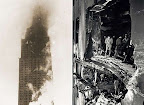On the foggy morning of Saturday, July 28, 1945, at 9:49 AM, a U. S. Army B-25D Mitchell Bomber, flown by ace fighter pilot LTC William F. Smith, MMI ’38, USMA ’42, plowed into the Empire State Building in New York City. Smith and his two crew members and 11 civilians in the building were killed. The accident was a strange precursor to the events of 9/11 involving the World Trade Center in New York City.
LTC William Franklin Smith, Jr., MMI ’38, USMA ’42. His MMI nickname was “Liver Lips.” (Credit: http://www.brightok.net/)

A native of Latham, Alabama, William Franklin Smith, Jr. (1918-1945), graduated from Marion Military Institute with the A.A. degree in 1938. His nickname at MMI was “Liver Lips!” Smith entered the United States Military Academy at West Point, became an All-American lacrosse player, and graduated in the Class of 1942. Trained to be an Army fighter pilot, Smith served in the European Theatre during World War II for two years, amassing over a thousand hours of flight time including 34 combat missions, and winning two Distinguish Flying Crosses, four Air Medals, and the French Croix de Guerre.
1944: LTC Smith commanding the 750th Squadron, 457th Bombardment Group during World War II. (Credit: http://www.457bombgroup.org/)

This particular flight originated in New Bedford, MA, and attempts to land at LaGuardia Airport in New York City were unsuccessful due to a blanket of dense fog and clouds which had socked the city in. Diverted to the Newark, NJ, airport, the tower at LaGuardia radioed LTC Smith that the ceiling was near zero and that forward visibility was limited to three miles only. The air traffic controller added: “From where I’m sitting, I can’t see the top of the Empire State Building.”
A B-25D Mitchell Bomber like the one LTC Smith was flying on that fateful day. (Credit: Jennifer Rosenberg, The American Dream)

At 9:48AM, witnesses on the ground saw Smith’s bomber barely miss Rockefeller Center, flying at about 500 feet. Then, the plane banked sharply and disappeared into the fog. Officials believe that LTC Smith had found a break in the clouds, that he saw a curved river ahead which he thought was the East River (it was actually the Hudson River), and that he then descended to 225 mph thinking that he was approaching the Newark Airport. Instead, he was on a course straight for the Empire State Building! Smith tried too late to veer away, and struck the 78th and 79th floors of the 102-story building’s north end. The impact – at the 913 foot level – tore an 18 x 20 foot gash in the building, and ignited a blazing inferno. In all, 14 people - Smith and his two crew members and 11 people working in the offices affected – were killed, and 26 others received severe wounds or burns. Material damages ran more than one million dollars.
LTC Smith was 27 years-old.
The burning Empire State Building and the gaping hole in its north side. (Credit: http://www.aerospaceweb.org/)

The building in flames from another vantage point. (Credit: http://www.aerospaceweb.org/)

The Army attempted to pay restitution to the victims of the crash into the Empire State Building, then the world’s tallest building. Some people accepted money, but a major lawsuit was initiated that resulted in landmark legislation for the nation. The Federal Tort Claims Act of 1946, allowed Americans – for the first time – to sue the Federal government.











